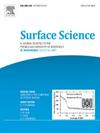Diamond surface nano-structures in an oxidizing atmosphere: A first principles study
IF 2.1
4区 化学
Q3 CHEMISTRY, PHYSICAL
引用次数: 0
Abstract
Diamond’s unique properties has found it numerous applications in electronics, optics and medicine. As desirable are diamond’s potential applications, it is notoriously difficult to process on the nanoscale. A new and promising mechanism involving a two-photon laser induced desorption could solve many of these problems. However, the underlying mechanism of this process is still not well understood; what is known, is that oxygen plays an important role. Therefore a detailed and consistent understanding of the fundamental behaviour of oxygen on diamond surfaces is required. In the present paper, systematic density-functional theory calculations are performed to investigate the interaction of oxygen with the low-index surfaces of diamond, taking into account the effect of pressure and temperature. This affords predictions of the surface atomic structures, including the newly discovered keto-ether structure on the surface, and the associated properties such as the adsorption energies, work-function, surface dipole moment, electron density difference, density of states, and electronic bandstructure. By including the effect of the environment, namely, the oxygen pressure and temperature in which the surface is held, surface phase diagrams are obtained. From these results, and using the Wulff construction, the shape of oxygen-terminated nanoparticles are predicted. Further, using the calculated surface free energies, the surface populations of different structures on the , and surfaces as a function of temperature, for both atmospheric pressure and ultra high vacuum conditions are evaluated. Interestingly, the results predict that although the full monolayer bridge site on has the highest population, the top site ketone structure can be populated by as much as 20% and coexist. Regarding the half monolayer bridge structure on the reconstructed surface, the bandstructure shows that it possesses no surface states in the band gap making it attractive for quantum sensing applications and is the most favourable structure at this coverage. Interestingly, the calculations predict another structure that is only 0.02 eV less favourable and so is likely to coexist on the surface. Overall, the present work provides a most comprehensive theoretical understanding of the interaction of oxygen with the low index diamond surfaces, which may be valuable for future studies of this system.

氧化气氛中金刚石表面纳米结构:第一性原理研究
金刚石的独特性质使其在电子、光学和医学上得到了广泛的应用。虽然金刚石的潜在应用是令人向往的,但在纳米尺度上加工金刚石是出了名的困难。一个新的和有前途的机制涉及双光子激光诱导解吸可以解决许多这些问题。然而,这一过程的潜在机制仍然没有得到很好的理解;我们所知道的是,氧气起着重要的作用。因此,需要对氧气在金刚石表面的基本行为进行详细和一致的了解。本文采用系统的密度泛函理论计算,在考虑压力和温度影响的情况下,研究了氧与金刚石低折射率表面的相互作用。这提供了表面原子结构的预测,包括在C(110)表面上新发现的酮醚结构,以及相关的性质,如吸附能、功函数、表面偶极矩、电子密度差、态密度和电子带结构。通过考虑环境的影响,即保持表面的氧气压力和温度,可以得到表面相图。根据这些结果,并利用Wulff结构,预测了端氧纳米粒子的形状。此外,利用计算得到的表面自由能,计算了常压和超高真空条件下C(100)、C(110)和C(111)表面上不同结构的表面占比随温度的变化规律。有趣的是,结果预测,尽管C(100)上的全单层桥位点人口最多,但顶部位点酮结构的人口可高达20%并共存。对于重建的C(111)−(1×2)表面上的半单层桥结构,带结构表明它在带隙中不具有表面态,这使得它对量子传感应用具有吸引力,并且是该覆盖范围内最有利的结构。有趣的是,计算预测了另一种结构,这种结构的有利条件只有0.02电子伏特,因此很可能在表面上共存。总的来说,本工作提供了氧与低指数金刚石表面相互作用的最全面的理论认识,这可能对该体系的未来研究有价值。
本文章由计算机程序翻译,如有差异,请以英文原文为准。
求助全文
约1分钟内获得全文
求助全文
来源期刊

Surface Science
化学-物理:凝聚态物理
CiteScore
3.30
自引率
5.30%
发文量
137
审稿时长
25 days
期刊介绍:
Surface Science is devoted to elucidating the fundamental aspects of chemistry and physics occurring at a wide range of surfaces and interfaces and to disseminating this knowledge fast. The journal welcomes a broad spectrum of topics, including but not limited to:
• model systems (e.g. in Ultra High Vacuum) under well-controlled reactive conditions
• nanoscale science and engineering, including manipulation of matter at the atomic/molecular scale and assembly phenomena
• reactivity of surfaces as related to various applied areas including heterogeneous catalysis, chemistry at electrified interfaces, and semiconductors functionalization
• phenomena at interfaces relevant to energy storage and conversion, and fuels production and utilization
• surface reactivity for environmental protection and pollution remediation
• interactions at surfaces of soft matter, including polymers and biomaterials.
Both experimental and theoretical work, including modeling, is within the scope of the journal. Work published in Surface Science reaches a wide readership, from chemistry and physics to biology and materials science and engineering, providing an excellent forum for cross-fertilization of ideas and broad dissemination of scientific discoveries.
 求助内容:
求助内容: 应助结果提醒方式:
应助结果提醒方式:


